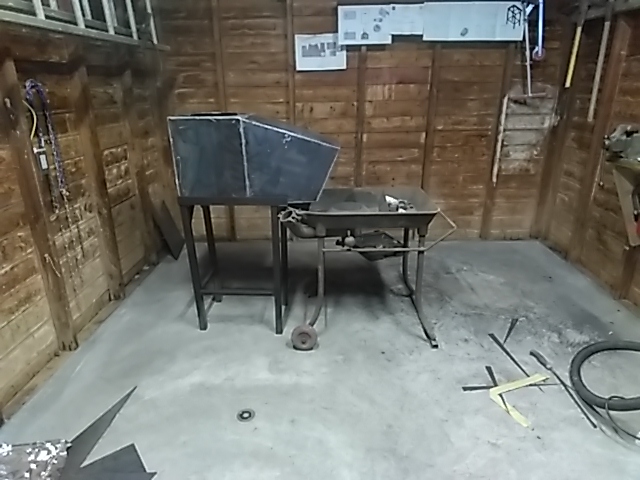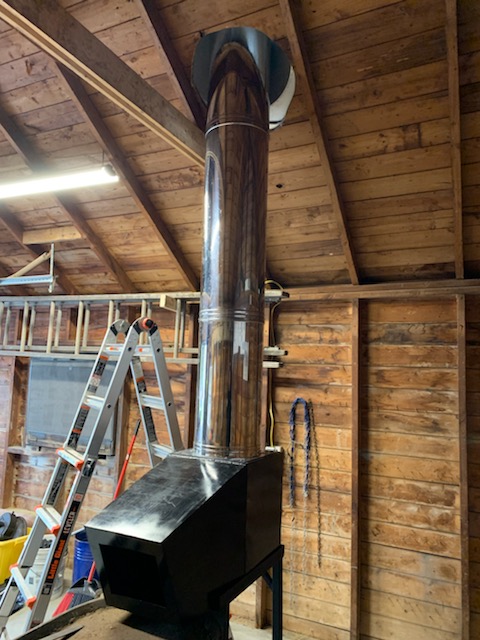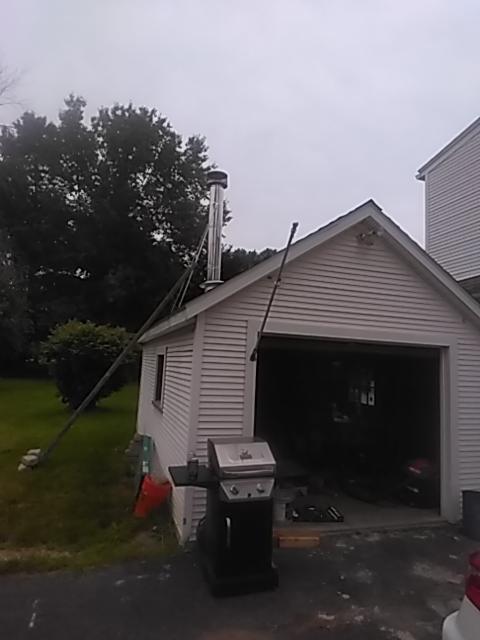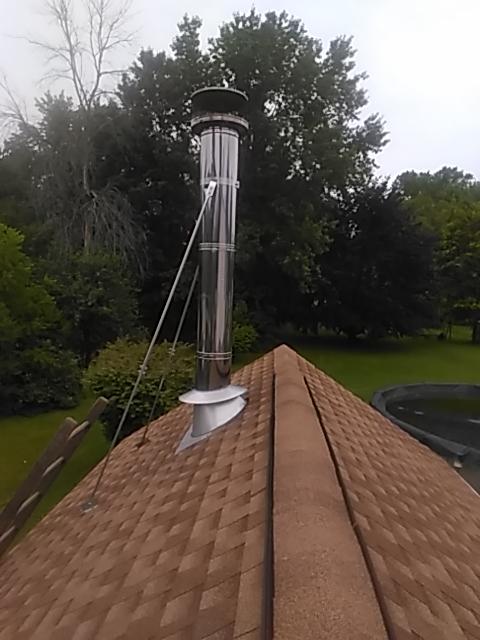-
Posts
1,403 -
Joined
-
Last visited
Content Type
Profiles
Forums
Articles
Gallery
Downloads
Events
Everything posted by Frazer
-
PB, Assuming you could find a treatment that could sufficiently harden the surface steel and not migrate at forge welding temperatures then I don't see why it wouldn't work. It'd be like a San Mai, but with a really thin center layer.
-
I wonder if the cherry red would survive forge welding temps. Carbon migration would certainly be be an issue... In any case, cherry red will also not make mild steel as hard as I would want a knife to be.
-
If you go back to the wiki page you posted a while back and explore some of the links embedded in the webpage you will find the information you're looking for...
-
For fun, you can fold it a few times and forge weld it into thicker stock!
-

Chimney/roof penetration design
Frazer replied to ClevelandGuy's topic in Building, Designing a Shop
Just an FYI, no need to quote me if my post is the one just above yours. In general, if there is a specific part you're responding to you can highlight that sentence/phrase and click the little "quote selection" button that appears. No big deal, it just saves people from reading the same thing twice and eliminates some clutter. I hear you, and you are probably right that FIF (etc.) has resulted in more people putting together some improvised solutions than ever before. It took me a couple of years to be able to move my shop indoors and get myself setup and that included a move into my first house. I was also worried that all my plans would be foiled right when they were starting to come together, but since I knew I was serious about the hobby I didn't want to take any chances. I'm not telling you what to do with your shop. It seems like you're capable of making your own decisions. I would just recommend calling around and getting a few opinions on what would be required. They might say it's impossible to do legally OR they might save you a few bucks in parts by telling you what you do and don't need. Either way you'll know more than you do now. -

Chimney/roof penetration design
Frazer replied to ClevelandGuy's topic in Building, Designing a Shop
While I understand it can be a headache I can't advocate for putting in an illegal setup. It might seem unnecessarily restrictive, but the fire code does exist for a reason and there are potential downstream effects of choosing to ignore it. If you ever need to file a claim for your home insurance, even if it's not related to the chimney, it's hard to hide a 10-12" pipe sticking out of a garage. They will almost certainly ask when and how it was installed. If you don't the right answers they might make you take it down anyway or drop you altogether. If it is related to the forge/chimney (in any way) you have given them a really good reason not to cover the damages. I think the logic behind not putting a solid fuel-burning appliance in an attached garage is pretty self explanatory, so I won't belabor the point.. However, like I mentioned before the local laws can vary pretty widely. If you don't want to go directly to the town and ask questions then I would highly recommend going to a local chimney installer and asking them to come in and take a look at the space and explain what your options are. They will be familiar with your local laws and might be able to provide you with some guidance on how to get yourself setup properly. Just be prepared for them not to know what a forge is or have a clear picture of what you're trying to do without a pretty clear explanation. If you're interested in familiarizing yourself with the national code, NFPA 211 is the national standard and is available online. If you would like a link PM me and I can share a previous release. It's not the most current version (you have to pay for that), but all of the relevant sections are in there. An important caveat is that not every town has adopted every section of the national code. A local company will be able to provide you with a lot more information on what applies to you. My intent isn't to make this sound more daunting than it needs to be. I'm just a guy online and I don't claim to be an expert (or even especially knowledgeable) in this by any means. Latticino is much more experienced than I am. Call up a local company and pick their brain. Then you can make a more informed decision on how to proceed. Keep us posted on how things are going. -

Need bar stock for tooling.
Frazer replied to USANewbie's topic in Blacksmithing, General Discussion
Jobitel, I wouldn't harden the struck ends. I use 4140 for my dies and even hardening/tempering the working ends is arguably unnecessary. My butchering dies and flat dies I did harden and temper, but the fullering dies that I made more recently were just normalized. They all work equally well. One thing I'll add about guillotine tools in general is that they are very handy, but can be pretty inefficient from a transfer of energy perspective. So when selecting the cross section of your dies don't go any bigger (thicker) than you need to. My dies are 0.75 x 1.5" and I ended up grinding down some of the the flats on the flat dies to reduce the amount of material that's being worked on at a time. -

Chimney/roof penetration design
Frazer replied to ClevelandGuy's topic in Building, Designing a Shop
Agreed to everything above. However, I needed 36" of clearance from the appliance (aka forge/hood assembly), then a 2" clearance at the penetration. My stack was originally ~3' above the peak, but at the request of a neighbor who reported smoke traveling down the roof toward his house I added another 4' section. For the sake of clarity, this is incorrect. It's 15' tall... -

Chimney/roof penetration design
Frazer replied to ClevelandGuy's topic in Building, Designing a Shop
Your forge and general approach sound very similar to how my build went. I also removed the overhead hood and added a modified super sucker hood in its place. I ended up going straight up and out rather than going through the wall. To meet my local code I had to put a DuraTech 10" system in (the DuraVent is for enclosed masonry fireplaces and apparently isn't intended to be run exposed). I have no idea what temperature the flue gasses are, but I can say after running the forge for several hours I can touch the first few inches of pipe somewhat comfortably. By the top of the first 3' section the pipe it's pretty much room temp to slightly warm. The nice thing about a coal forge and 10" pipe is the flue gasses are significantly diluted by all of the ambient air. This is something you should make clear to to your AHJ (if you're doing this legally, which personally I recommend you do). Most of the weight of the stack is supported by the frame I fabbricobbled up for the hood. There is also a support kit on the roof, but that doesn't bear any load. The stack is 19' tall, extends 7' beyond the peak of the roof and will suck the hammer out of your hand if you aren't holding it tight.... ok maybe the last bit is a slight exaggeration, but you get the idea. My setup is inspected and legal in my area, but it should not be used as a blueprint for you... Local laws vary widely by location. I just saw your pictures... You're going to have a hard time installing a solid fuel burning appliance in an attached garage. Not only might there be some legal hurdles, but your insurance company is going to fight you on that... Not to rain on your parade; it's worth a shot. However, don't expect it to be as easy as buying some pipe and slapping it up... it's not. I don't know anything about Ohio fire code so I may be way off base on the attached garage thing, but in my area that's essentially a do not pass go, do not collect $200. Ok, I actually read the post with your pictures this time... Sorry, it sounds like it is a detached garage, but you don't have a more recent picture. My bad. -
I also turn the blower with my tong hand.. Primarily because of the way my forge was made. The blower is mounted on the left side and I'm right-handed. It would be silly for me to cross my arms and crank with my right hand while continuing to use my tong hand for manipulating the stock. The blower continues to spin for 3+ rotations after I let go. While forge welding I will also generally let the pieces soak for a few seconds with no air before pulling them out. Those two factors leave me plenty of time to get my hands situated where they need to be. I think it's fair to say that whatever way you're accustomed to work and can work most efficiently with is the correct way.
-
Agreed on everything said above. I know you can only make runs for material every so often, but any of the raw stock you'll find at a big box store is generally going to be sold as "weldable" steel. That is code for (overpriced) structural steel. However, there are other items in the store that aren't sold as flat/bar stock that could be used.. Whether they're cheaper than buying a bar of a known starting material online or at a steel supply is questionable, but I'll put that aside for the moment. When selecting a mystery steel it can be helpful to consider what it was used for in the past. To name a few examples, it's fairly safe to assume something like a file, spring, chisel, crowbar, lawnmower blade, etc. is going to be made out of some sort of hardenable steel or other. It was once hard (or at least hard-ish) so in theory it can be returned to that state. Is this a guarantee that every lawnmower blade is going to be ideal for any type of knife? No.. but that's why you test mystery steel first. If you're buying flat stock new and neither you nor any of the employees in the store know what alloy it is then it's safe to assume it's A36 and not suitable for making knives. If it's mystery steel that you're looking to repurpose, try to pick "tool steels". In this context I mean steels that are intended to perform a particular set of tasks where an increased hardness or toughness would be beneficial.
-

What did you do in the shop today?
Frazer replied to Mark Ling's topic in Blacksmithing, General Discussion
Oooooh. Pretty... Very nice Rojo, I'm sure she'll love it. -
Not the copper pipe leading up to the Ts, I think he's talking about the air/fuel mixing tube (black iron pipe) going into the forge.. According to Frosty's T burner instructions the length to diameter ratio should be 8:1.
-
I do not have that book... Would you mind sharing a few? Boxwood is a very dense and stable wood. Apparently it has been used for instruments for a couple thousand years..
-
Ha, yes. I had a 2-3" thick piece of RR track kicking around the shop for a while and I decided that if I decapitated it it would make for a good hammer blank. Fast forward a couple of hours (I have learned that RR track is some tough stuff to forge down by hand) I had the blank squared up and the eye partially opened up. I said to myself, "*Whew* it's hot out here!" and put the hammer partially in the fire and went inside to refill my water bottle with some nice refreshing ice water... This was back when I was still using an electric blower for air and coincidentally I had recently switched over from a hair dryer to a much quieter furnace blower that had two settings: on (plugged in) and off (unplugged). Rather than unplugging the blower every time I would generally point it away from the tuyere to greater or lesser extent to control the air.... Well this time I forgot to do that. By the time I came back I walked out to a beautiful volcano of sparks erupting out of the forge. The hammer had reproduced by fission but it did not survive the process.. It also made quite the mess inside the fire pot. Shortly thereafter I got a speed controller for the blower complete with an easily accessible on/off switch... Now I use a hand crank and I'm pretty fond of it. Anyway, that's my hammer of shame story. The moral is don't leave things unattended in the fire even if you'll, "only be gone for a second".
-
I have a box of shame for my more memorable scrap making exercises.. Damascus that split during the quench, a hammer I burnt in half by leaving it unattended, particularly ugly firsts, etc.. Then I have the scrap pile where practice pieces and the like go to potentially be repurposed later. And by that I mean collect dust and get buried
-
Before I started stabilizing with cactus juice (for the sake of transparency this is a relatively new development) I used to finish my knife handles with stain and polyurethane.. IMHO sealing the scales is better than trying to avoid getting them wet. Selecting woods that are relatively stable naturally is something to keep in mind. Stable woods maintain their dimensions well with changes in humidity and/or moisture content and some (but not all) "stable" woods have natural rot restive properties. I'm not saying unstabilized oak etc. scales won't work and if it's your knife then use whatever wood you like and care for it accordingly. I'm just saying that there are many naturally stable woods out there that are worth looking into.
-
No exception here. Diamonds fall under the definition provided above.
-
So diamonds aren't minerals? If not, what are they? ...wait. diamonds are inorganic. Apologies.
-

what coal can reach 2000 degrees F
Frazer replied to coleyjp's topic in Smelting, Melting, Foundry, and Casting
See if there are any classes available locally before you spend money on the PPE and whatever materials you might need to get started. YT videos can be useful, but they can't replace in person instruction from people who know what they're doing. Additionally, if you put your general location in your profile you may find there are other members in your area who can help. -

what coal can reach 2000 degrees F
Frazer replied to coleyjp's topic in Smelting, Melting, Foundry, and Casting
Just An FYI, links to commercial sites (amazon, ebay, etc.) aren't allowed. Please take a moment to read the following to get the most out of the site: Just because PoP can't withstand high temperatures doesn't mean there aren't other options available to use. Not having any experience with melting metals (on purpose) I'll leave it to others to suggest options. Have you ever done any melting before or are you just getting started? -

what coal can reach 2000 degrees F
Frazer replied to coleyjp's topic in Smelting, Melting, Foundry, and Casting
Under the right conditions any coal can far exceed 2000F.. So can charcoal.. A word of warning: Be careful what instructions you're following on YouTube. I'm not familiar with "King of Random" but based on the channel name it doesn't seem like the sort of source I would trust for info on building a furnace. -
There are many reasons why a channel may stop posting videos. Best not to jump to conclusions. By the way, welcome aboard! Please take a moment to read the following to help you get the most out of the site:
-
White vinegar.... Or by replacing the apron. *grin*
-
I think we are going to need some more information to be able to answer your question. What kind of forge are you using? Have you tried resisting the urge to take the steel out of the fire and leaving it in there longer? What are you trying to make and what kind of steel are you using? etc. etc. The more detail you provide the better equipped we are to help you out. We aren't mind readers.... yet. By the way, welcome aboard. Please take a moment to read the following. It will help you get the most out of the site.




